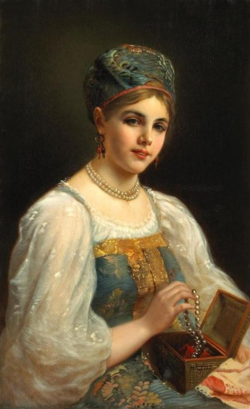Karenina Accord
The Karenina Accord was the Haeseni women’s rights movement, occurring in the years 409-414 E.S, which resulted in the official Karenina Law being passed unanimously in Duma. With it, absolute primogeniture was introduced to the Kingdom, and both men and women were declared equal under Haeseni law. It was named so after Queen Emma Karenina of Haense, who acted as a figurehead for the movement.
Contents
Summary of Events
The Formation (409 E.S. - 414 E.S.)
Lively conversation and debate was sparked at one of Queen Emma Karenina’s council meetings in the year 409 E.S. The Haeseni women were inspired by those Orenian women who had petitioned for the Rosemoor Bill, and consequently their discussions took form into a plan for impassioned campaigning of their own: a fight for equal succession. The Queen herself was elected leader and figurehead of the Accord at that same meeting, and the movement was titled ‘Karenina’.Months of campaigning followed. Of which, the largest rally swept Karosgrad’s square in 410 E.S, organised by Queen Emma. Calls for absolute primogeniture and equality rang out, as women crowded the steps to the Nikirala Palace. They called for justice, for the legal push for womens’ succession. Each supporter sported a pink rose, pinned to their breast, or entangled in their hair. The Queen lit a large pyre so that it burned pink smoke - her favoured colour, and thus, the symbol of the campaign. With the flames at her back, she stood on a small pedestal before the crowds, and made her public speech.
The women were faced with plenty of opposition, for many more conservative Haensemen were fixed in old ways. In Duma, Lord Konstanz Barclay brought discussions regarding succession to be debated among Haeseni peers. There, the Queen and her ladies made their case, garnering support. Ladies Theodosya Mondblume, Erika Barclay and Analiesa Ludovar had campaigned for seats in Duma to further support the movement, and all were elected as Royal Alderwomen and Grand Maer respectively. This election year was so significant as it was the first time in the history of Duma that the elected officials were all women.
Realising tackling the Haeseni lords as a collective would be a challenge, Queen Emma invited each to her offices individually, partaking in extensive private talks regarding the movement for many weeks. She attempted to convince them whenever she could to endorse the Accord, and eventually succeeded in winning the support from each.
All the women’s hard work culminated in the Duma of 414 E.S. The Karenina Law was drafted as a bill by the Lord Palatine, Duke Eirik Baruch and Lady Erika Barclay, and was subsequently voted on and passed unanimously. The celebrations sounded across the city for many days, thereafter.
The Aftermath
Women and men are now perceived as entirely equal under the law, and have equal inheritance rights to noble land and titles. The Kingdom of Haense’s succession transitioned from male primogeniture to absolute primogeniture. With this, Lady Isabel Baruch was named heir-apparent, instead of heir-presumptive, and future Duchess of Valwyck. A statue was later raised in the city by Erika Vatornik, previously Barclay, to commemorate the movement and its success.
Poetry Inspired By the Movement
Reflections:
Why is it that
(Though perhaps this is my womanly fretting)
That despite that I am His wife
(And, I insist, a full woman besides)
I am rewarded with naught but
A miserable kind of near-existence
They never listen attentively
(As when He has spoken)
A half-person
Living a half-life
Sudden Awakening:
The ribbon pink upon my breast,
And twined within my hair,
Is the sign of half a nation
Our call for justice bare
In every feminine soul,
A great opening yawns wide;
The manacles within me burst,
My inner man is cast aside
I feel the power in my heart
I feel a pulsing in my brow
I taste a rising on my tongue:
'Emancipation now!'
Both penned by the Haeseni National Poet, Dietrich van Jungingen.
Important figures
- Her Royal Majesty, Emma Karenina Queen-Consort of Haense - as the figurehead and leader of the movement, the Queen commanded the ladies in her Council, organised rallies, campaigned in Duma, and won the support of leading peers.
- His Excellency the Lord Palatine, Duke Eirik Baruch - as Lord Palatine, the Duke of Valwyck was a pillar of support for the movement. He co-wrote the finalised bill in 414 E.S.
- Lady Erika Barclay - one of the first voices to spark discussions among the women, Erika campaigned in Duma for the Accord’s passing and co-wrote the Karenina Law in 414 E.S.
- Lady Theodosya Mondblume - was elected Royal Alderwoman, and thus continued the women’s campaign into Duma.
- Lady Analiesa Ludovar - was elected Grand Maer by popular support, and represented the women’s cause in Duma.
